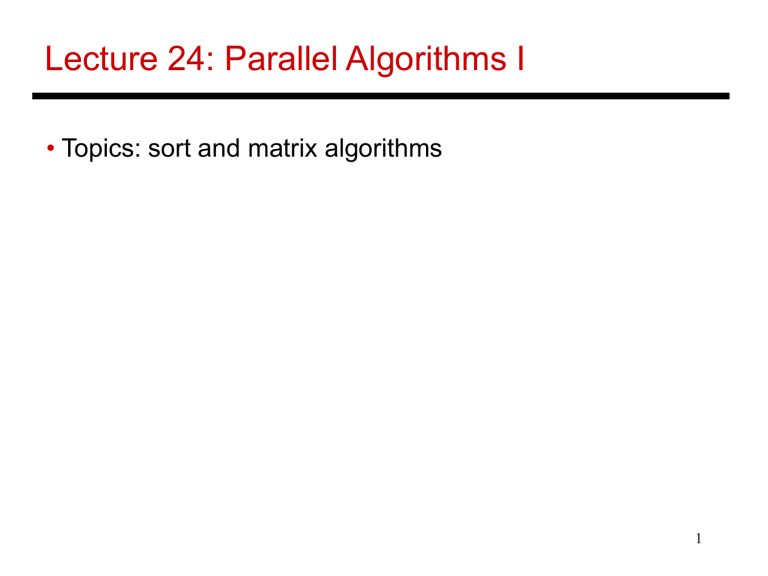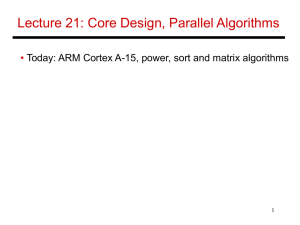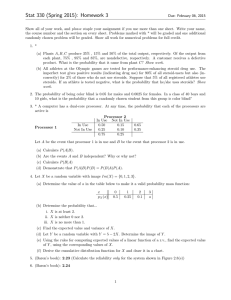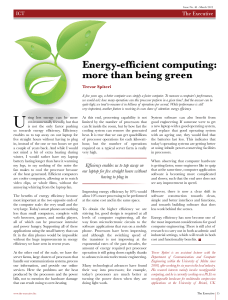Lecture 24: Parallel Algorithms I • Topics: sort and matrix algorithms 1

Lecture 24: Parallel Algorithms I
• Topics: sort and matrix algorithms
1
Processor Model
• High communication latencies pursue coarse-grain parallelism (the focus of the course so far)
• For upcoming lectures, focus on fine-grain parallelism
• VLSI improvements enough transistors to accommodate numerous processing units on a chip and (relatively) low communication latencies
• Consider a special-purpose processor with thousands of processing units, each with small-bit ALUs and limited register storage
2
Sorting on a Linear Array
• Each processor has bidirectional links to its neighbors
• All processors share a single clock (asynchronous designs will require minor modifications)
• At each clock, processors receive inputs from neighbors, perform computations, generate output for neighbors, and update local storage input output
3
Control at Each Processor
• Each processor stores the minimum number it has seen
• Initial value in storage and on network is “ * ”, which is bigger than any input and also means “no signal”
• On receiving number Y from left neighbor, the processor keeps the smaller of Y and current storage Z, and passes the larger to the right neighbor
4
Sorting Example
5
Result Output
• The output process begins when a processor receives a non-
* , followed by a “ * ”
• Each processor forwards its storage to its left neighbor and subsequent data it receives from right neighbors
• How many steps does it take to sort N numbers?
• What is the speedup and efficiency?
6
Output Example
7
Bit Model
• The bit model affords a more precise measure of complexity – we will now assume that each processor can only operate on a bit at a time
• To compare N k-bit words, you may now need an N x k
2-d array of bit processors
8
Comparison Strategies
• Strategy 1: Bits travel horizontally, keep/swap signals travel vertically – after at most 2k steps, each processor knows which number must be moved to the right – 2kN steps in the worst case
• Strategy 2: Use a tree to communicate information on which number is greater – after 2logk steps, each processor knows which number must be moved to the right – 2Nlogk steps
• Can we do better?
9
Strategy 2: Column of Trees
10
Pipelined Comparison
Input numbers: 3 4 2
0 1 0
1 0 1
1 0 0
11
Complexity
• How long does it take to sort N k-bit numbers?
(2N – 1) + (k – 1) + N (for output)
• (With a 2d array of processors) Can we do even better?
• How do we prove optimality?
12
Lower Bounds
• Input/Output bandwidth: Nk bits are being input/output with k pins – requires W
(N) time
• Diameter: the comparison at processor (1,1) influences the value of the bit stored at processor (N,k) – for example, N-1 numbers are 011..1 and the last number is either 00…0 or 10…0 – it takes at least N+k-2 steps for information to travel across the diameter
• Bisection width: if processors in one half require the results computed by the other half, the bisection bandwidth imposes a minimum completion time
13
Counter Example
• N 1-bit numbers that need to be sorted with a binary tree
• Since bisection bandwidth is 2 and each number may be in the wrong half, will any algorithm take at least N/2 steps?
14
Counting Algorithm
• It takes O(logN) time for each intermediate node to add the contents in the subtree and forward the result to the parent, one bit at a time
• After the root has computed the number of 1’s, this number is communicated to the leaves – the leaves accordingly set their output to 0 or 1
• Each half only needs to know the number of 1’s in the other half (logN-1 bits) – therefore, the algorithm takes
W
(logN) time
• Careful when estimating lower bounds!
15
Matrix Algorithms
• Consider matrix-vector multiplication: y i
=
S j a ij x j
• The sequential algorithm takes 2N 2 – N operations
• With an N-cell linear array, can we implement matrix-vector multiplication in O(N) time?
16
Matrix Vector Multiplication
Number of steps = ?
17
Matrix Vector Multiplication
Number of steps = 2N – 1
18
Matrix-Matrix Multiplication
Number of time steps = ?
19
Matrix-Matrix Multiplication
Number of time steps = 3N – 2
20
Complexity
• The algorithm implementations on the linear arrays have speedups that are linear in the number of processors – an efficiency of O(1)
• It is possible to improve these algorithms by a constant factor, for example, by inputting values directly to each processor in the first step and providing wraparound edges
(N time steps)
21
Solving Systems of Equations
• Given an N x N lower triangular matrix A and an N-vector b , solve for x , where A x = b (assume solution exists) a
11 x
1 a
21 x
1
= b
1
+ a
22 x
2
= b
2
, and so on…
22
Equation Solver
23
Equation Solver Example
• When an x, b, and a meet at a cell, ax is subtracted from b
• When b and a meet at cell 1, b is divided by a to become x
24
Complexity
• Time steps = 2N – 1
• Speedup = O(N), efficiency = O(1)
• Note that half the processors are idle every time step – can improve efficiency by solving two interleaved equation systems simultaneously
25
Title
• Bullet
26




